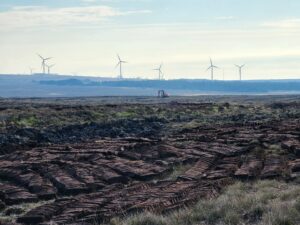John Lusby
The fifth national survey of Hen Harriers in 2022 published by the National Parks and Wildlife Service reveals shocking declines in this iconic bird of prey of our hills and mountains.
Only 85 confirmed pairs of Hen Harrier were recorded throughout the country by the survey, representing the most severe decline of any national survey to date.
The survey was undertaken by a partnership of the Golden Eagle Trust, Irish Raptor Study Group and BirdWatch Ireland on behalf of the National Parks and Wildlife Service. Similar to previous surveys, the 2022 national survey received enthusiastic support from a substantial network of voluntary surveyors including birdwatchers, farmers, wildlife rangers, foresters and biologists with more than 250 fieldworkers dedicating over 7,700 hours to the survey.

Hen Harrier. Photo: Mike Brown
Despite these collective efforts, the Hen Harrier has been pushed closer to the brink of extinction. The current national population estimate of 85-106 breeding pairs in 2022 represents a decline of one-third (33%) in the total population since the 2015 national survey which previously recorded 108-157 pairs and also showed a 27% contraction in their breeding range for the same period.
A comparison of Hen Harrier numbers in specific survey squares which were covered across the various national surveys reveals that Hen Harriers have declined by a shocking 59% since the first national survey in 1998-2000. At the current rate of decline, population extinction could be expected within 25 years and there could be fewer than 50 breeding pairs of Hen Harrier remaining within the next 10 years.
In 2007, as a requirement under the EU Birds Directive, Ireland designated six sites in upland areas as Special Protected Areas (SPAs), based on their national importance for breeding Hen Harriers at that time. The 2022 survey revealed that Hen Harrier populations in five of these SPAs have declined by between 20% and 80% since 2007, when they were identified for designation. Overall, the SPA populations have declined by more than half (54 %) in the same period.
Hen Harrier. Photo: Mike Brown.
John Lusby, Raptor Conservation Officer, of BirdWatch Ireland who coordinated the survey alongside project partners said: “We have reached crisis point at this stage, the situation could not be more serious, and we need to act accordingly if we are to stand any chance of ensuring Hen Harriers don’t become extinct within our lifetimes”.
He continued: “Hen Harriers are one of the best studied bird species in Ireland. We know the main reasons why their populations have declined to such low levels, which has been primarily driven by land-use changes resulting in the loss of habitat for Hen Harrier in our uplands, due to afforestation on important habitats for Hen Harrier and other wildlife inside and outside the Special Protection Area network, as well as associated disturbances from forest management activities and other pressures including wind energy developments. These pressures in combination have affected the integrity of our uplands, which are some of our most important areas for biodiversity and we are now seeing the very real effects of poor spatial planning and management of our uplands on Hen Harrier populations”.
Many pressures which have degraded our upland habitats have contributed to the Hen Harrier population declines. Photo: John Lusby
Oonagh Duggan, Head of Advocacy with BirdWatch Ireland, commented: “We know what needs to be done to save this species. Government knows what needs to be done but it is not acting. Government recently issued a draft Threat Response Plan for Hen Harrier for public consultation which was ten years in the making. During this time the species declined by a third. It has vague actions and is lacking ambition. It is just not good enough. This is a litmus test for government and its new National Biodiversity Action Plan which has an objective to halt the deterioration of 30% of species with unfavourable status by 2030.
“We will be launching a campaign soon so that members of the public can offer support to save the skydancing Hen Harrier from extinction. All national Hen Harrier breeding and wintering sites must be protected from afforestation, forest management activities and wind energy development. Habitat restoration for these important areas is also critical and we need long-term and well-funded agri-environment scheme to support farmers for their conservation efforts”.
Dr Marc Ruddock, one of the report authors working for the Golden Eagle Trust, and Jamie Bailey secretary of the Irish Raptor Study Group confirmed that both organisations are thankful to all the surveyors involved and are pleased at the publication of the Irish Wildlife Manual to help inform conservation actions. However, they were dismayed at the findings and such significant declines observed in the Hen Harrier population.
Jamie Bailey commented: “The publication of the Hen Harrier survey represents a huge testament to the more than 250 volunteers and surveyors that searched systematically, often fruitlessly, for the species across Ireland in 2022 and their dedication and expertise is hugely valued. Many IRSG members having surveyed the species for many decades noted that so many of these areas that once were strongholds for the species now appear functionally extinct for the Hen Harrier”.
View the 2022 National Survey of Breeding Hen Harrier in Ireland Report here.




